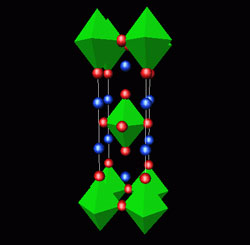Ghost of Superconductivity on a Fall Day

Materials that conduct electricity without resistance continue to surprise physicists. In the April Physical Review B, one of the so-called high-temperature superconducting (HTS) materials shows a magnetic effect typical of superconductivity even at the temperature of a cool autumn day–far above its temperature for resistance-free current. The results reinforce other experiments suggesting that a “shadow” of the superconducting state exists even when the material appears normal and may give clues about the underlying causes of the HTS phenomenon.
Superconductivity occurs if electrons form pairs when a material is cooled. These pairs can join to form a collective quantum mechanical state that extends throughout a chunk of material and carries electric current with no resistance. In “traditional” superconductors like aluminum, this state forms at the same ultra low temperature as the electron pairs do. By contrast, the HTS materials show indications of pairs even near room temperature but become superconducting only at much lower temperatures (though still warm compared with traditional superconductors). One model proposes that pairing occurs only in narrow “stripes,” while resistance-free electric current is blocked by intervening stripes of magnetism [1].
Christos Panagopoulos and his team at Cambridge University, England, explored a different aspect of the high-temperature behavior of a lanthanum-strontium-copper-oxygen compound, one of the first HTS materials discovered. First the team placed a sample in a small magnetic field. They then cooled it, measuring how much field passed through the sample. Next, they switched the order, cooling first, then applying the magnetic field. In the second case, the field piercing the sample was smaller by a few percent, even though the final temperature and external field were the same in both cases.
The slight difference is called a history effect. The standard explanation is that superconductors confine any penetrating magnetic fields to isolated narrow tubes called vortices. When the field is applied to a superconducting sample, the vortices can’t form “in place” but must shoulder their way in from the edges. Sometimes they get stuck, and others are left waiting outside the sample. In the sample cooled in the field, on the other hand, the field is already present when the vortices form.
Panagopoulos and his colleagues were surprised to find similar history effects in the superconducting state–below 40 kelvin–and at temperatures as warm as 290 kelvin, about 10 degrees below room temperature. The history effect at low temperatures comes from vortices, which form only in a superconductor. The team suggests that even at higher temperatures something resembling superconductivity may be present in small regions, as the stripes model suggests.
Other researchers have also seen signs of vortices in the non-superconducting state. For example, Phuan Ong and his colleagues at Princeton University in New Jersey recently observed other indirect signs of vortices far above the temperature range for superconductivity in HTS materials [2]. But those effects did not extend to temperatures as warm as the history effect does. The researchers aren’t sure whether the two experiments are related, but Panagopoulos says that seeing similar outcomes in two very different experiments mean that “people just can’t ignore it anymore.”
Steve Kivelson, of the University of California at Los Angeles, says these results are “very striking,” and that both the new results and the earlier observations “are telling us something important” about HTS materials in their non-superconducting state. But he suspects the quirky magnetic behavior might be a signature of an unusual magnetic state that encourages superconductivity, rather than a sign of superconductivity itself.
–Don Monroe
Don Monroe is a freelance science writer in Murray Hill, New Jersey.
References
- S. A. Kivelson et al., “How to detect fluctuating stripes in the high-temperature superconductors,” Rev. Mod. Phys. 75, 1201 (2003) see also Phys. Rev. Focus 9, story 12 (2002)
- Y. Wang et al., “High Field Phase Diagram of Cuprates Derived from the Nernst Effect,” Phys. Rev. Lett 88 257003 (2002)
More Information
Focus story from 1999


